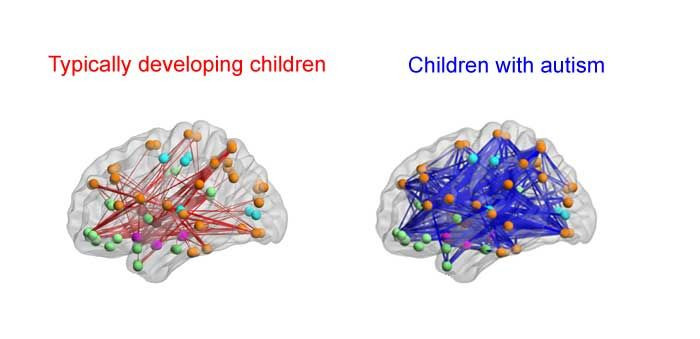Kids With Autism Have Hyperconnected Brain Areas: Could Brain Imaging One Day Diagnose The Disorder?

Advances in neuroimaging and electrophysiology have made it possible to explore and map the circuitry of the brain. Using such technology, a recent study found that the brains of children with autism show more connections when compared with others. This ‘hyperconnectedness,’ the researchers hypothesize, may be the underlying cause of at least some of their developmental issues.
"Our study addresses one of the hottest open questions in autism research," Kaustubh Supekar, of Stanford University School of Medicine and co-author of the study, stated in a press release. "We demonstrate that the brains of children with autism are hyper-connected in ways that are related to the severity of social impairment exhibited by these children."
In an independent, though related, study from San Diego State University, a team of researchers found an unusual increase in connections in neighboring brain regions, particularly areas of the brain that control vision. What’s more, this overconnectivity was linked to the severity of symptoms.
Brain 'Wiring'
Brain wiring, like genetics, is as individual as each of us. When scientists speak of brain circuitry, they are referring to the fact that the brain’s nearly 100 billion neurons each have 10,000 to 100,000 synaptic connections — and every one of these connections must be precisely attached to corresponding neurons to form circuits. Yet, though a multitude of connections exist within the brain and though each individual brain is wired uniquely, general patterns of connectivity emerge when viewing a range of brains. Among these patterns, scientists speak of structural connectivity and functional connectivity. Structural connectivity refers to literaral wiring of neurons and regions, piece to piece. Functional connectivity, though, is slightly more abstract in that it refers to when groups of neurons from regions both near and far act together in a coherent manner. Neurological events in separate brain regions typically occur in concert, so to speak, in order to produce some physiological result, such as vision.
Generally, then, researchers agree that autism spectrum disorder (ASD), a neurodevelopmental condition affecting nearly one in 88 children, is linked to 'atypical' brain connectivity. The point of disagreement among scientists, though, is the exact nature of these aberrations in connectivity. For instance, some studies have found that functional connectivity in adolescents and adults with autism is generally reduced compared with their peers who do not have the disorder, while functional connectivity in younger children with autism appears to be increased. Currently, scientists are exploring autistic brain circuitry in order to understand more precisely how it performs… or fails to perform.
Independent Studies
In the San Diego State University study, then, researchers wanted to understand local connectivity within the brain. To that end, they used functional connectivity MRI and graph theory in order to analyze the brains of participants who were considered "high-functioning" and with IQs above 70. They discovered that in the temporal and occipital regions of both hemispheres — the regions of the brain that control vision — functional connectivity was increased in adolescents with ASD compared with typically developing adolescents. Further, they found this type of overconnectivity was associated with higher ASD symptom severity.
"Our findings support the special status of the visual system in children with heavier symptom load," Müller, a co-author of the study, stated in a press release. On the other hand, when analyzing the data for those with less severe symptoms, the team saw underconnectivity in frontal brain regions.
“The findings suggest links between symptomatology and local connectivity, which vary within the autism spectrum,” the authors wrote. The researchers believe measures of local connectivity may be used to aid diagnosis and complement the existing behavioral criteria.
For the Stanford Study, the researchers used one of the largest pediatric functional neuroimaging datasets created to date in order to characterize whole-brain connectivity in children. Along with the discovery of hyperconnections in the brains of children with autism, they also found a relationship to the severity of social impairment. In particular, they observed hyperconnectivity at the whole-brain and subsystems levels, across both long- and short-range connections. This unusual circuitry was found to be related to higher levels of fluctuations in regional brain signals. The team also discovered that hyperconnectivity predicted symptom severity; children with greater functional connectivity exhibited more severe social deficits.
"Our findings suggest that the imbalance of excitation and inhibition in the local brain circuits could engender cognitive and behavioral deficits observed in autism," Menon said. That imbalance is a hallmark of epilepsy as well, which might explain why children with autism so often suffer with epilepsy too. For Supekar and Menon, these new views of the autistic brain raise the intriguing possibility that epilepsy drugs might be used to treat autism.
Sources: Keown CL, Shih P, Muller RA, et al. Local functional overconnectivity in posterior brain regions is associated with symptom severity in autism spectrum disorders. Cell Reports. 2013.
Supekar K, Menon V, Uddin LQ, et al. Brain Hyperconnectivity in Children with Autism and its Links to Social Deficits. Cell Reports. 2013.



























